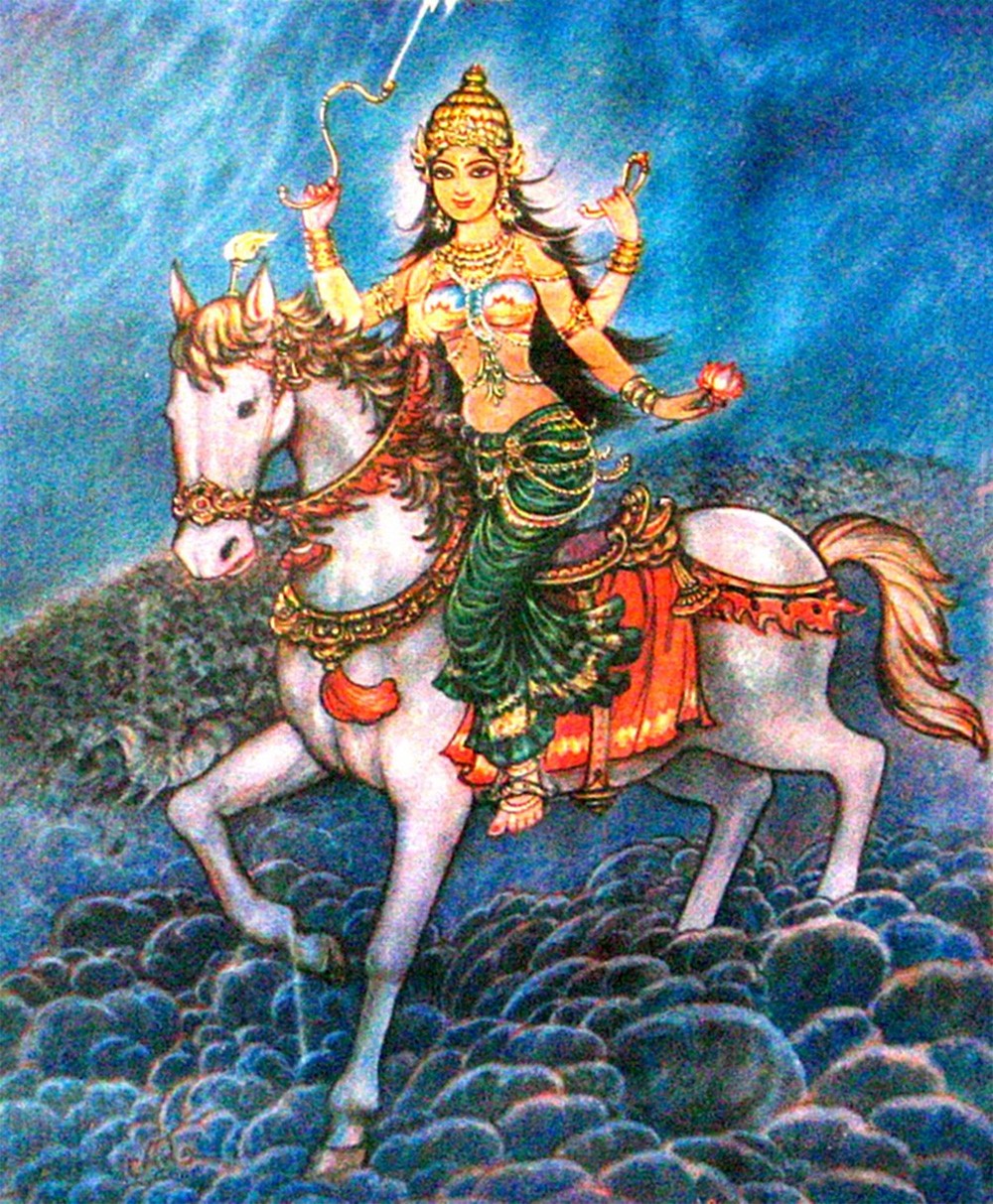
Śrī Aśvārūḍhāmbā is the Pratyaṅga deity of Srī Lalitāmbikā, created from Her noose. She is the twenty-third raśmimālā mantra. She is seated on a horse called Aparājitā - undefeated. In Lalitopākhyānā, during the war with Bhaṇḍāsura, She killed Kuruṇḍa on the first day and Ulūkajit on the third day.
Her dhyāna śloka is:
badhvā pāśenāṅkuśena kṛṣyamāṇā svasādhyakaṁ |
ghnantīṁ vetreṇa valkāsṛk pāṇiṁ aśvāsanām bhaje ||
badhvā pāśenā = Tied with a noose; āṅkuśena kṛṣyamāṇā = pulled by goad; svasādhyakaṁ = The intended person; ghnantīṁ vetreṇa = hitting him with a whip; valkāsṛk pāṇiṁ = hands red with blood; aśvāsanām bhaje = I adore one who is seated on a horse.
The mantra of Aśvārūḍhāmbā as per Kalpa Sútra is:
pranavah pāśāditryarnā ehi parameśvarītyuktvā
vahni vāmākṣyuktir iti śrī pratyaṅgaṁ aśvārūdhā | PKS 10.31
Praṇavaḥ = Oṁ; pāśāditryarṇā = three syllables from pāśā, which are pāśā, māyā and aṅkuśa - āṁ hrīm kroṁ; ehi parameśvarītyuktvā = say ‘ehi parameśvari’; vahni-vāmākṣyuktir = along with wife of agni - svāhā; iti śrī-pratyaṅgam aśvārūḍhā = This is Pratyaṅga of Lalitāmbā, Aśvārūḍhā.
The mantra runs thus:
oṁ āṁ hrīṁ kroṁ ehi parameśvarī svāhā
badhvā pāśena: tied up with rope (noose), we find that the bīja, in all tantra dictionaries, for the noose — pāśa is ‘āṁ’
aṅkuśena: goad, in the tantric dictionaries, goad bīja is ‘kroṁ’
kṛṣyamāṣā: pulled by (the goad) — both of the above acts tying and pulling will point to the movement in the mantra is ‘ehi’
svasādhyakaṁ: whatever is to be subdued, won, or desired by the self, or in other contexts, it will refer to an intended person, who is an enemy. These will point to the ari șat (six internal enemies) who have to be won over by continuous sādhana. The hṛllekhā bīja aptly describe this ‘hrīṁ’
ghnantīm vetreṇa valkāsṛk pāṇiṁ: killed by the bark whip (or a skin whip) smeared with blood in her hands. The swish of a whip relates to the sound produced, the blood is mantra adhvā, thus we find primordial sound as said ādi (first) mantra — ‘oṁ’
Devata aṅga >>> ādhva
śiras (head) >>> padādhvā
keśa, roma (hair) >>> bhuvanādhvā
tvak (skin) >>> varnādhvā
śukla, majjā, asthi >>> tattvādhvā
sarvāṅga >>> kalādhvā
rudhira/ ābharașa (blood/ornaments) >>> mantrādhvā
aśvāsanāṁ: seated on a horse. This is an allegory to the lord of mind (Horse represents mind) knowledge. Thus pointing to ‘parameśvarī’.
bhaje: I praise. ‘svāhā’ can be split as su+āhā, meaning well done - praise.
The horse is a symbol of breath, which in turn is ‘gross mind’. Thus riding horses is riding mental modifications and thoughts. ‘śva’ also means tomorrow, ‘a’ is a negation. Thus ‘aśva’ will mean no-tomorrow, which means ‘the present’. Thus keeping awareness in present is a symbol evolved here. ‘Parā’ also means the highest ‘a’ is again negation, thus point to the mundane. ‘jita’ means conquered. So we find a conquering of the mundane by being keeping our awareness in the present.
‘kuruṇḍa’ will point to common green leaf vegetable too, thus showing us mundane, conquest by simple breath exercises- prānāyāma will signify defeat on the first day, or in parlance initial sādhana krama. Later in sādhana, depicted as the fourth day, the slaying of Ulūkajit - who is the vanquisher of Indra (Indriya nātha - lord of five senses, thus pointing the mastery of sensual governance) will now point to sādhana of bhūta suddhi wherein prānāyāma is combined with bhāvana for removal of āṇava mala.
‘O Lord Datta here is a flower at your feet’
Source: "Meditative Texts - Revised Thoughts on the Way" by Yogamba Sameta Atmanandanatha (Ramesh Kutticad)
Yogamba Sahita Atmanandantha (Ramesh Kutticad) is a Śrī Vidyā Guru from Chennai. He is associated with Guruji since 1996. Smt. and Sri Ramesh have painstakingly written the following scholarly, research. We're grateful to him for allowing us to make these articles available for the public.

